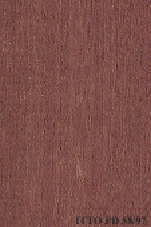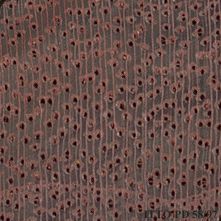
AMARANTE, PURPLEHEART (Peltogyne paniculata)
Trade Name
Amarante, Purpleheart
Scientific Name
Peltogyne paniculata Benth.
Family
LEGUMINOSAE
Common Names
Violeta (Brazil); Roxinho (Brazil); Pau-Roxo-Da-Várzea (Brazil); Pau-Roxo (Brazil); Guaré (Brazil); Cinzeiro (Brazil); Guarabu (Brazil); Tananeo; Morado; Pau Roxo (Brazil); Purperhart; Sakavalli; Saka; Koroboreli; Violetwood; Purpleheart; Bois Pourpre; Pourpre; Bois Violet; Sakaballi; Sapater; Zapatero; Sacka; Palo Morado; Palo Cocha; Nazareno; Violet; Tannaneo; Violet Wood; Marawineroo; Koruburelli; Kooroobooelli; Amarante; Amaranth; Amaranto; Purple Wood; Purple Heart
Scientific Name Synonyms
Peltogyne venosa (Vahl) Benth.; Peltogyne pubescens Benth. ; Peltogyne confertiflora (Hayne) Benth.; Peltogyne amplissima Pittier; Hymenaea venosa Vahl; Hymenaea confertifolia Hayne
Description Of The Tree
Botanical Description
Two sub-species with similar wood characteristics and distribution are reported, P. paniculata ssp paniculata and ssp pubescens. Some variation is reported according to the species, but it is often about 25 to 35 m in height, with a trunk diameter of abou
Natural Distribution
This species is reported to be widely distributed all over Central and northern South America.
Non Timber Uses
The wood presents gums which affect wood processing.
Wood Identification
Anatomic Description Of Wood
Wood diffuse porous. Vessels solitary and in short radial multiples. Tangential diameter of vessel lumina 100 micras or less (very small). Occasionally vessels with colored deposits. Occasionally white deposits in heartwood vessels. Vessels per mm2 10 to 20 (a Axial parenchyma in marginal or in seemingly marginal bands. Paratracheal axial parenchyma scanty and/or vasicentric. Axial parenchyma aliform. Axial parenchyma confluent. Occasionally pith fleck. Occasionally axial parenchyma storied. Prismatic crystals in cha Rays non-storied. Rays 1 to 4 seriate. Homogeneous rays and/or sub-homogeneous rays (all ray cells procumbent). Fibers with simple to minutely bordered pits.
-
 Wood Macro Photo Tangential Plane
Wood Macro Photo Tangential Plane
-
 Wood Micro Photo Of Transversal Section
Wood Micro Photo Of Transversal Section
Availability
Cites Status
Unrestricted
General Wood Description
Odor
The wood has no specific odor or taste.
Color
The sapwood is white, clearly differentiated from the heartwood which is dark red to purple when dry.
COLOR INDEX (1=Black, 7=Light yellow,white)
3
Grain
The grain is typically straight or wavy and sometimes interlocked.
Texture
Texture is mostly fine to medium.
Luster
The wood exhibits a moderate to high luster.
Natural Durability
The heartwood is resistant to decay fungi attack and to termites, but it is less resistant to marine borers.
Natural durability index (1= Very high durability, 7=Vey low durability)
2
Resistance To Impregnation
It is very difficult to treat, but for most applications preservative treatments are not required.
Wood Physical Properties
Basic Density or Specific Gravity (O.D. weight/vol. green) (g/cm³)
0.71
Air-dry Density (Weight and volume at 12%MC) (g/cm³)
0.80
Total shrinkage Tangential (Saturated to 0%MC) (%)
6.8
Total shrinkage Radial (Saturated to 0%MC) (%)
4.4
Drying Defects
Drying Defects: Risk of checking and warping is reported. Kiln Schedules: Slow drying is recommended.
Recommended Dry Kiln Schedule
UK-E; US-T6-D2
Dimensional stability ratio (Total Tangential Shrinkage %/Total Radial Shrinkage %)
1.6
Wood Chemical Properties
Wood Mechanical Properties
Bending Strength (MOR),12%MC (kgf/cm²)
1430
Stiffness (MOE) 12%MC (kgf/cm²)
163500
Compression parallel to fiber 12%MC (kgf/cm²)
842
Compression perpendicular to fiber 12%MC (kgf/cm²)
203
Shear strength radial 12%MC (kgf/cm²)
156
Janka hardness (side) 12%MC (kgf)
1197
Janka hardness (end grain) 12%MC (kgf)
1343
Workability
Sawing
The wood is hard and it contains resins that affect sawing.
Rotary Veneer Cutting
This species is interesting for slicing, thermal treatments are recommended.
Sliced Veneer
This species is interesting for slicing, thermal treatments are recommended.
Blunting Effect
It is considered to have a moderate blunting effect on the cutting elements.
Machining
Peltogyne is reported to be moderately difficult to work in most machining operations including planing, turning, boring, and molding. They respond rather poorly to ordinary tools, and working with dull cutters may cause the wood to heat up.
Planing
A reduction of the cutting angle to 15 degrees is required, when wavy or interlocked material is present, to obtain satisfactory results in planing.
Turning
30
Nailing
It has a tendency to split. Pre-boring is indispensable.
Gluing
The timber is reported to glue well.
Sanding
It is easy to sand.
Finishing
Organic solvents remove the characteristic purple color. To preserve the natural color, wax finishing is recommended.
Steam Bending
The wood steam bends fairly well.
Response To Hand Tools
Response to hand tools is reported to be only fair.
REFERENCED USES
End Uses Summary
HOUSING GENERAL, beams, flooring, parquet, FURNITURE AND CABINETS, luxury furniture, cabinets, TURNING, TOOLS, tool handles, NAVAL CONSTRUCTION, OTHER AND MUSICAL INSTRUMENTS, handicrafts, coffin
General Housing
- 10 - Silica in Timbers
Beams
- 11 - Prospect: The wood database
Flooring
- 14 - Handbook of Hardwoods
Parquet
- 15 - Empire Timbers
Furniture Cabinets
- 21 - Tropical timbers of the world. Part III-Southeast Asian and Oceanian Species.
Furniture, Luxury
- 22 - Dry kiln schedules for commercial woods. Temperate and tropical. Section IV-Asian and Oceanian Woods
Cabinet
- 24 - Empire Timbers
Turning
- 30 - Embassy of Honduras in Japan
Tools
- 42 - Utilización Industrial de Nuevas Especies Forestales en el Perú.
Tool Handles
- 43 - Maderas de Bolivia (Características y Usos de 55 Maderas Tropicales)
Shipbuilding
- 55 - Tropical Timber Atlas of Latin America
Handcraft
- 66 - Maderas latinoamericanas. VII. Caracteristicas anatomicas. propiedades fisicomecanicas, de secado, y tratabilidad de la madera juvenil de Cordia alliodora (Ruiz & Pav. Oken.)
Coffin
- 78 - Amazonian Timbers for the International Market
Please Provide Information To View Producer Information